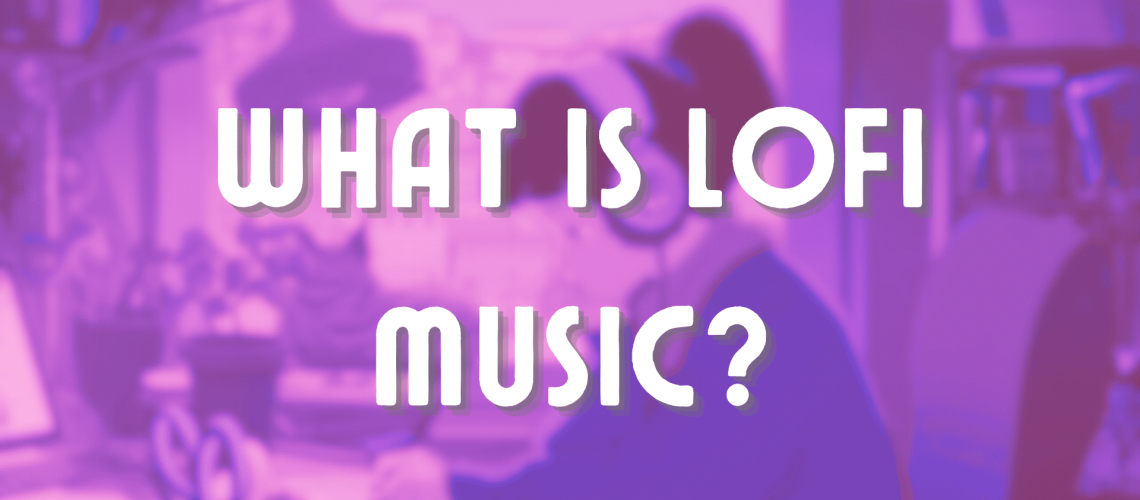LoFi, short for low-fidelity, is a genre that embraces imperfections.
It’s like the comfortable, worn-out sweater of the music world—cozy, familiar, and unpretentious.
You’ve surely heard of the LoFi study girl on YouTube… But do you know what truly makes LoFi… LoFi? In this guide, we’ll break down the specific characteristics of LoFi music, focusing on drums, bass, synths, and other sounds that make this genre unique.
Let’s go!
LoFi Music: Where Does it Come From?
LoFi music is more than just a genre; it’s a cultural movement that values authenticity and simplicity.
The term “LoFi” originally referred to the lower quality of sound recordings, where imperfections such as background noise and distortions were considered flaws.
However, over time, these imperfections became celebrated as a distinct aesthetic choice.

LoFi music traces its roots back to the DIY culture of the 1980s and 1990s. During this period, musicians and producers began to embrace the limitations of home recording equipment. Instead of aiming for the polished sound of professional studios, they leaned into the quirks and character of their gear.
LoFi music was born from the mix of two major culture movements:
Firstly, cassette culture: the rise of cassette tapes in the 1980s played a crucial role in the development of LoFi music. Cassettes were affordable and accessible, allowing musicians to record and distribute their music without the need for expensive studio time. This led to a flourishing underground music scene, where artists could experiment freely.
Indie and Punk movements also played an influence. The indie rock and punk scenes were instrumental in shaping the ethos of LoFi music. Bands like The Velvet Underground and The Shaggs exemplified the DIY spirit, producing raw and unpolished recordings that resonated with fans who valued authenticity over technical perfection.
Now that we’ve set the stage, let’s examine the key components of LoFi music.
Characteristics of LoFi Music
LoFi is an umbrella term. So technically, it could apply to any genre of music. You could have LoFi Techno, LoFi Riddim… Ok maybe not LoFi Riddim. But you get the point.
However, the most popular form of LoFi music is by far LoFi Hip Hop. This is what we’ll examine now.

I’ve broken down this next section into 3 parts. Firstly, we’ll look at the general aesthetic of LoFi music (i.e. what producers are aiming for). Next, we’ll dive into individual components of LoFi music, such as drums, bass and more. Finally, we’ll talk more about general production techniques and the overall listener experience.
The aesthetics of LoFi music
LoFi music celebrates flaws and imperfection. It’s the opposite of polished pop music. Here, imperfections are what makes the music… human. They are what gives character and warmth to the track.
So, what kind of imperfections are we talking about? Here are some examples:
- Tape Hiss and Vinyl Crackle. This is probably the first thing people think of when you say “LoFi”. Imagine the sound of an old record player. That’s tape hiss and vinyl crackle. These sounds are like seasoning—they add a vintage flavor to the music.

- Out-of-tune instruments. LoFi music will often feature intentionnally de-tuned instruments or loops. This is often referred to as “wow and flutter“. This is a phenomenon common with old turntables. Basically, the playback speed accidentally varies, creating variations in pitch. This effect is sought-after by LoFi producers. Check out this example:
- Swing and Groove. LoFi beats often swing. They can swing lightly, or they can swing wildly. What this means is that individual hits (often hi-hats and percussion) are off-the-grid. This creates a human feel, making it sound like a real drummer, not a machine.
- Analog Warmth: LoFi tracks often use analog instruments, which give a warm, rich sound. This is like the difference between the warmth of a live acoustic guitar and the cool precision of a digital recording. Analog warmth can also be achieved through the use of analog-style effects such as analog compression, analog saturation etc.
Drums, bass, vocals… What makes up LoFi music?
Now that we have a sense for the general vibe of a LoFi track, let’s go a bit further.
The drums
Drums in LoFi music are mellow and laid-back. They set a relaxed vibe, like a gentle heartbeat. They often take a back step to the rest of the instruments (think the opposite of dubstep or drum and bass).
Namely, LoFi music features soft kicks and snares.
They are usually subdued by removing a lot of the high-end and snappiness. Think of them as a whisper rather than a shout. The pattern is usually minimalist: not flashy, just solid and steady.

As mentioned previously, hi-hats and percussion elements will often be off tempo. Additionally, they are often in a triplets pattern.
The bass
In terms of bass, it needs to provide depth and warmth.
- Deep, Warm Tones: Bass lines are deep and smooth. They’re like the comforting rumble of distant thunder.
- Simple Patterns: The bass lines are usually straightforward and repetitive. They’re easy to follow, grounding the listener.
- Subtle Modulations: Producers add slight variations to keep the bass interesting. It’s like a subtle spice that enhances the flavor without overpowering it.
Synths and melodies
Finally, synths and melodies are the heart of LoFi music, creating its dreamy, ethereal quality.

- Soft, Dreamy Synths: Synth sounds are often soft and lush. They create a dreamy atmosphere.
- Ambient Pads: These are sustained tones that fill out the background. They’re like the ambient noise in a coffee shop—always there, but not demanding attention.
- Mellow Leads: Melodic leads are understated. They’re not about flashy solos but gentle, soothing lines that enhance the mood.
LoFi music will often feature piano as the main source of chordal structure and melody. Again, this can be recorded through MIDI or sampled.
The cherry on top: atmospheres
LoFi music is rich in additional sounds that add layers of interest. Remember, we’re trying to create a comforting, soothing mood.
- Field Recordings: Natural sounds like rain or birdsong are often included. These add an immersive element, making the listener feel like they’re in a different place.
- Vocal Samples: Snippets of dialogue or random vocal sounds are used to add a human touch. They can convey emotion or just add an interesting texture.
Production Techniques and Listener Experience
Finally, let’s look at some of the production techniques used in LoFi music.
Sampling old records or cassettes is common. Producers manipulate these samples to fit the track, adding a vintage vibe. They will also use modern loops, but degrade them to make them sound like they were sampled of old vinyls.
Effects and layering also play a role. Reverb, delay, and other effects are used to shape the sound. These effects create space and depth, making the music feel expansive. Layering on the other hand is used to create rich textures. This adds depth and complexity to the track.
LoFi music is one of the very rare genres of electronic music meant almost exclusively for home listening.
This is why LoFi music needs to connect emotionally with listeners. It often needs to be nostalgic, relaxing, and introspective. That’s why it’s often the backdrop for deep thinking, meditation or work.
Artists to Check Out
If you’re new to LoFi music or looking to expand your playlist, here are five artists that exemplify the genre.
Nujabes
Nujabes, the stage name of Japanese producer Jun Seba, is often credited with pioneering the LoFi hip-hop movement. His tracks blend jazz samples with hip-hop beats, creating a soulful, introspective sound. Albums like Metaphorical Music and Modal Soul are essential listening.
J Dilla
As mentioned earlier, J Dilla’s influence on LoFi and hip-hop is immense. His album Donuts, created during his final days, is a masterclass in sampling and beat-making. The imperfect loops and raw emotion in his music have inspired countless producers.

Tomppabeats
Much closer to what people expect of modern LoFi music, Tomppabeats is a Finnish producer known for his chill, laid-back beats. His album Harbor is a great introduction to his style, featuring smooth melodies and nostalgic samples that capture the essence of LoFi.
Jinsang
Jinsang is another prominent figure in the LoFi scene, with a sound that’s both relaxing and emotive. His music is perfect for unwinding or studying, featuring mellow beats and soothing melodies.
Idealism
Idealism is a producer who excels at creating atmospheric, ambient LoFi tracks. His music often features lush synths and gentle beats, providing a perfect backdrop for relaxation and reflection.
Final Words on LoFi Music
That’s it for this guide! Hopefully you know have a better understanding of what LoFi music is, and what sets it apart from other genres. Got any questions? Anything unclear? Let me know over at [email protected]




